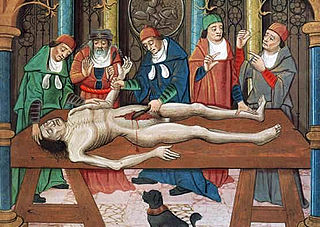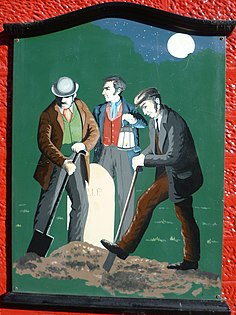Posthumous execution is the ritual or ceremonial mutilation of an already dead body as a punishment. It is typically performed to show that even in death, one cannot escape justice.

The history of anatomy extends from the earliest examinations of sacrificial victims to the sophisticated analyses of the body performed by modern scientists. The study of human anatomy can be traced back thousands of years, at least to the Egyptians, but the science of anatomy, as we know it today, did not develop until far later. The development of the study of anatomy gradually built upon concepts that were understood during the time of Galen and slowly became a part of the traditional medical curriculum. It has been characterized, over time, by a continually developing understanding of the functions of organs and structures in the body.

Jefferson , commonly known as Thomas Jefferson University, is a private university in Philadelphia, Pennsylvania. It was formed in 2017 through the merger of Philadelphia University and Thomas Jefferson University.

The history of anatomy in the 19th century saw anatomists largely finalise and systematise the descriptive human anatomy of the previous century. The discipline also progressed to establish growing sources of knowledge in histology and developmental biology, not only of humans but also of animals.

Dissection is the dismembering of the body of a deceased animal or plant to study its anatomical structure. Autopsy is used in pathology and forensic medicine to determine the cause of death in humans. Less extensive dissection of plants and smaller animals preserved in a formaldehyde solution is typically carried out or demonstrated in biology and natural science classes in middle school and high school, while extensive dissections of cadavers of adults and children, both fresh and preserved are carried out by medical students in medical schools as a part of the teaching in subjects such as anatomy, pathology and forensic medicine. Consequently, dissection is typically conducted in a morgue or in an anatomy lab.

Cholera Riots refers to civil disturbances associated with an outbreak or epidemic of cholera.

The Anatomy Act 1832 is an Act of Parliament of the United Kingdom that gave freer licence to doctors, teachers of anatomy and bona fide medical students to dissect donated bodies. It was enacted in response to public revulsion at the illegal trade in corpses.
Gross anatomy is the study of anatomy at the visible or (macroscopic) level. The counterpart to gross anatomy is the field of histology, which studies microscopic anatomy.
The London Burkers were a group of body snatchers operating in London, who apparently modelled their activities on the notorious Burke and Hare murders. They came to prominence in 1831 for murdering victims to sell to anatomists, by luring and drugging them at their dwelling in the northern end of Bethnal Green, near St Leonard's, Shoreditch in London.
Night Doctors, also known as Night Riders, Night Witches, Ku Klux Doctors, and Student Doctors are bogeymen of African American folklore, with some factual basis. Emerging from the realities of grave robbing, enforced and punitive medical experimentation, and intimidation rumours spread maliciously by many Southern whites, the Night Doctors purpose was to further prevent slaves, Free Men, and black workers leaving for the North of the United States, in a prescient foreshadowing of the inevitable events during the early to mid 20th century, now known as The Great Migration.
An anatomy murder is a murder committed in order to use all or part of the cadaver for medical research or teaching. It is not a medicine murder because the body parts are not believed to have any medicinal use in themselves. The motive for the murder is created by the demand for cadavers for dissection, and the opportunity to learn anatomy and physiology as a result of the dissection. Rumors concerning the prevalence of anatomy murders are associated with the rise in demand for cadavers in research and teaching produced by the Scientific Revolution. During the 19th century, the sensational serial murders associated with Burke and Hare and the London Burkers led to legislation which provided scientists and medical schools with legal ways of obtaining cadavers. Rumors persist that anatomy murders are carried out wherever there is a high demand for cadavers. These rumors, like those concerning organ theft, are hard to substantiate, and may reflect continued, deep-held fears of the use of cadavers as commodities.

Resurrectionists were commonly employed by anatomists in the United Kingdom during the 18th and 19th centuries to exhume the bodies of the recently dead. Between 1506 and 1752 only a very few cadavers were available each year for anatomical research. The supply was increased when, in an attempt to intensify the deterrent effect of the death penalty, Parliament passed the Murder Act 1752. By allowing judges to substitute the public display of executed criminals with dissection, the new law significantly increased the number of bodies anatomists could legally access. This proved insufficient to meet the needs of the hospitals and teaching centres that opened during the 18th century. Corpses and their component parts became a commodity, but although the practice of disinterment was hated by the general public, bodies were not legally anyone's property. The resurrectionists therefore operated in a legal grey area.

Joseph Nash McDowell (1805-1868) was one of the most influential and respected doctors west of the Mississippi in the 1840s until his death in 1868. He is primarily remembered for his grave-digging practices, where he illegally exhumed corpses in order to study human anatomy. He is also known for his influence on Mark Twain, and was likely the inspiration for Twain's fictional character Dr. Robinson in "The Adventures of Tom Sawyer."
As anatomy classes in medical education proliferated in the 19th century, so too did the need for bodies to dissect. Grave robbery proliferated, along with associated social discontent, revulsion, and unhappiness. Conflicts arose between medical practitioners and defenders of bodies, graves and graveyards. This resulted in riots. Social legislation was passed in many countries to address the competing concerns.
The Law of 1794, derived from the Fourcroy Report of 1794, was enacted by the National Convention in December, 1794 in Paris, France. The law, stemming from a report from Antoine François, comte de Fourcroy, proposed the reorganization of the structure of medical education in post-revolution France and sought to lay the ground work for the institution of Hospital Medicine in France.
"An Act to Promote Medical Science and Protect Burial Grounds", informally known as the Bone Bill, was an 1854 bill in New York. Its purpose was to greatly increase the number of cadavers available for legal dissection in medical schools.
Lebanon Cemetery was an African-American cemetery in Philadelphia, Pennsylvania established in 1849. It was one of only two private African-American cemeteries in Philadelphia at the time. Lebanon Cemetery was condemned in 1899 and closed in 1903. The bodies were reinterred in 1902 to Eden Cemetery in Collingdale, Pennsylvania.

















